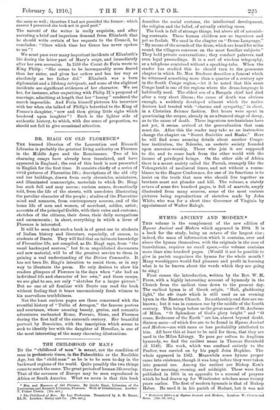DR. BIAGI ON OLD FLORENCE.* THE learned librarian of the
Laurentian and Riccardi Libraries is probably the greatest living authority on Florence in the Middle Ages and the Renaissance. Two of his charming essays have already been translated, and have appeared in England ; the rest of this book is now presented in English for the first time. It consists chiefly of a series of vivid pictures( of Florentine life ; descriptions of the old city and her buildings, drawn from early chronicles, miniatures, and illuminated manuscripts, materials to which Dr. Biagi has such full and easy access; curious scenes, dramatically told, from the life of the streets, with anecdotes illustrating the peculiar character of the people ; studies of the Florentine mind and manners, from contemporary sources, and of the home life of men and women, of merchant, soldier, artist; accouhts of the principal Guilds, with their rules and customs; sketches of the citizens, their dress, their daily occupations and amusements ; in short, everything in which a lover of Florence is interested.
It will be seen that such a book is of great use to students of Italian history and literature, especially, of course, to students of Dante. They will find that an intimate knowledge of Florentine life, not compiled, as Dr. Biagi says, from "the usual hackneyed sources," but frcm unpublished documents and new material, will be of the greatest service to them in gaining a real understanding of the Divina Ccrmmedia. It has not been Dr. Biagi's intention to assist them, or in any way to illustrate the poem. He only desires to show his readers glimpses of Florence in the days when "she had an individual life and character of her own," and these essays, we are glad to see, are only "sketches for a larger picture." But no one at all familiar with Dante can read the book without feeling that it bears unconsciously fresh witness to his marvellous truthfulness.
Not the least curious pages are those concerned with the eventful history of " Tullia of Arragon," the famous poetess and courtesan, whose amazing beauty, genius, and romantic adventures enchanted Rome, Ferrara, Siena, and Florence during the first half of the sixteenth century. Her beautiful portrait by Bonvicino, with the inscription which seems to seek to identify her with the daughter of Herodias, is one of the most interesting of the many charming illustrations.










































 Previous page
Previous page